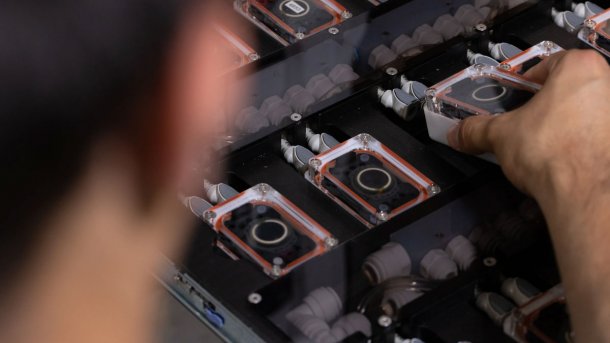Neuralink: Second patient receives brain-computer interface
The US start-up Neuralink has implanted its brain interface into a second volunteer. The operation went "very well", says Elon Musk.

Neuralink's N1 implants in a test device.
(Image: Neuralink)
The US start-up Neuralink has successfully implanted its brain interface in a second test subject. Neuralink founder Elon Musk explains this in the episode of the "Lex Fridman Podcast" published on Friday. The operation went well and the implant is working.
Neuralink is developing an implant designed to make it easier for paraplegics who can no longer move their arms and legs to use a computer and other interfaces. A surgical robot inserts an implant into the skull, from which 64 ultra-fine wires go into the regions of the brain that show increased activity when the arms and hands move.
Wires into the brain
Each of these wires is connected to 64 electrodes, which transmit electrical signals to the Neuralink software. The software interprets the signals and converts them into mouse movements on the connected device. This brain-computer interface is intended to make it easier for people with paraplegia from the neck onwards to operate a computer or other digital devices.
Around 400 of the electrodes worked in the second patient, Musk says in the podcast. "It seems to have gone extremely well with the second implant," says the Neuralink founder. "We have a lot of signals, a lot of electrodes. It's working very well." Musk hopes that another eight test subjects can be implanted by the end of the year.
The first participant in the study, who was implanted with Neuralink's "N1" implant at the beginning of the year, was able to play online chess and Mario Kart, for example. He was also able to control a computer cursor with his thoughts. For this to work, the software has to be trained on certain thought patterns that the patient consciously triggers.
More independence
The 29-year-old, who has been paralyzed down his neck since a diving accident, also has his say in the podcast episode, which is over eight hours long, alongside other Neuralink managers. The implant has given him back a certain degree of independence and reduced his dependence on care staff, he says.
In the first patient, the wires inserted precisely by a robot had shifted in the skull due to the natural movement of the brain, reducing the number of usable electrodes. Neuralink apparently knew that this could happen from previous experiments with animals.
However, Neuralink announced in July that the wires were now reasonably stable again after new tissue held them in place like an anchor. The company also wants to increase efficiency with improved algorithms. The first patient was able to increase his speed when controlling a cursor, although "only 10 to 15 percent of the electrodes work", says Musk.
(vbr)